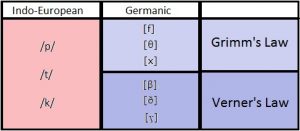Three Things All Germanic Languages Have in Common
By Sarah-Claire Jordan
 Germanic languages are spoken in Europe, North America, and Oceania, which includes Australia, New Zealand, and many other Pacific island nations. They can be further divided into three branches: North Germanic, West Germanic, and East Germanic. East Germanic languages no longer exist, but the other two branches show no signs of dying out any time soon. The West Germanic branch includes two of the most commonly spoken Germanic languages, German and English. The North Germanic languages include Swedish, Norwegian, Danish, Icelandic, and Faroese.
Germanic languages are spoken in Europe, North America, and Oceania, which includes Australia, New Zealand, and many other Pacific island nations. They can be further divided into three branches: North Germanic, West Germanic, and East Germanic. East Germanic languages no longer exist, but the other two branches show no signs of dying out any time soon. The West Germanic branch includes two of the most commonly spoken Germanic languages, German and English. The North Germanic languages include Swedish, Norwegian, Danish, Icelandic, and Faroese.
All Germanic languages descended from Proto-Germanic, or Common Germanic. Though they may seem incredibly different in many ways, they actually share many characteristics, thanks in part to their common ancestor. Here are three other characteristics that all Germanic languages share:
- Many different vowel qualities
Though English only has five letters that are consistently used to represent vowel sounds, the number of sounds that each letter represents is much more than five. In most dialects of English, there are about 11 or 12 vowel sounds. Other Germanic languages have even more vowel sounds, with Swedish coming in first with a whopping 17 different sounds. German and Dutch have about 14 different vowels, and Danish has about 11, very similar to English. This makes the Germanic languages particularly difficult to learn, especially for native speakers of languages that have very few vowel sounds, like Spanish. In turn, it can be difficult for native speakers of Germanic languages to grasp the idea that in some languages, namely Romance languages, an “e” only makes one kind of sound, no matter what other letters are next to it.
- Changes in sounds as outlined in Grimm’s Law
Grimm’s Law is also known as the First Germanic Sound Shift, which maybe gives you some idea of what it deals with. It can be broken down into three parts that all show changes that occurred when the Germanic languages broke away from Proto-Indo-European. Voiceless stops of Proto-Indo-European turned into voiceless fricatives in the Germanic languages. In English, voiceless stops would be the [p], [t], and [k] sounds, while voiceless fricatives include [f], [s], [h], [θ] (like the “th” in “bath”), and [ ʃ ] (“sh” of “should”), and [ʒ] (“s” in “pleasure”). The voiced stops of Proto-Indo-European ( [b], [d], and [g] sounds in English) became voiceless stops. Finally, the voiceless aspirated stops ( like the “p” sound in “punch”) found in Proto-Indo-European transformed into either voiced stops ( [b], [d], and [g] sounds in English) or voiced fricatives, which in English are [v], [z], [ð] (“th” in “father”), and [ʒ] (“s” in “pleasure”).
- Word order that includes putting the verb second
In all Germanic languages, you will notice that a verb must be preceded by one adverbial element or noun phrase, and not the other way around. If you want to get even more specific, the subject must follow a conjugated verb if there is a prepositional phrase or adverb right before it. This isn’t really seen in Modern English, except for dated phrases like “Pop goes the weasel” and questions like “How could you?” However, it is very noticeable in most of the other Germanic languages.
For an overview of our translation expertise, visit our technical translation service page.
Category: Foreign Language








